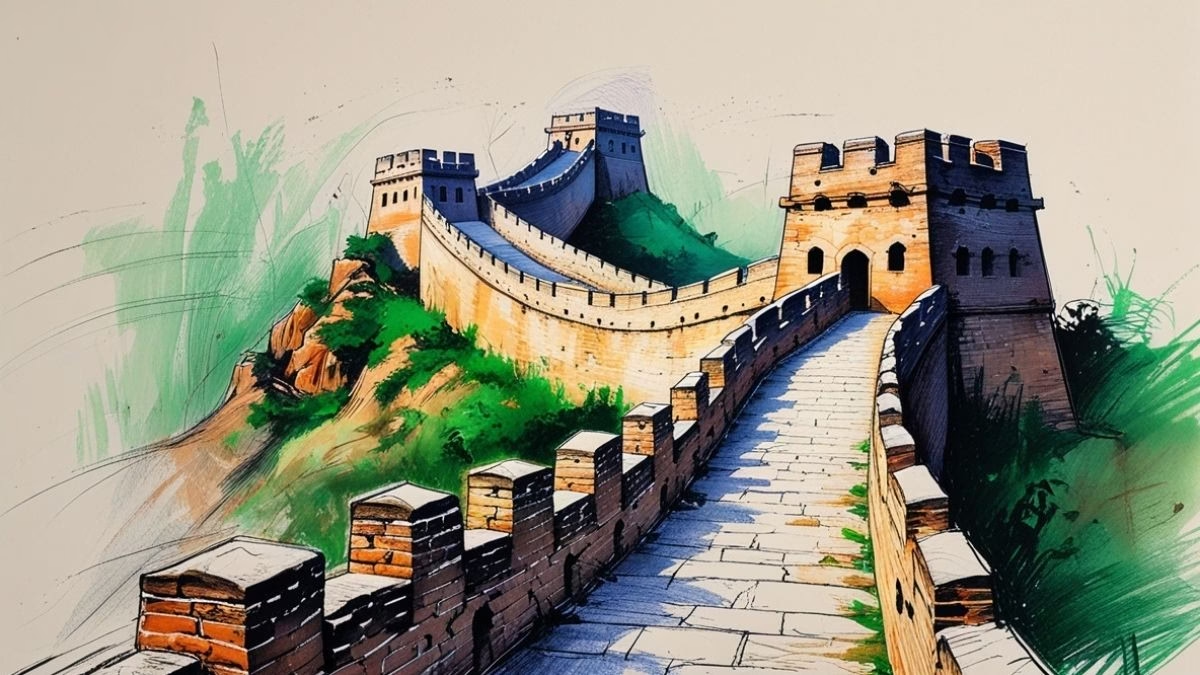Audio Episode
[ppp_patron_only level=5]
[/ppp_patron_only]
Introduction
Welcome, history explorers! Get ready to journey to one of the most famous structures on Earth: the Great Wall of China. We’ve all seen breathtaking photos of it snaking over majestic mountains, but this man-made wonder is surrounded by as many myths as it has bricks. Is it one single, continuous wall? Can you really see it from space? Who actually built it, and why?
This quiz is your chance to find out. It’s not a test, but a fun expedition through time to uncover the real story behind the legend. We’ll separate fact from fiction and discover the incredible secrets of its construction, its purpose, and its long and fascinating history.
By taking this quiz, you will:
- Bust a Few Myths: Learn the real answers to the common questions and misconceptions about the Great Wall.
- Travel Through Dynasties: Discover how the Wall was the work of many different eras, not just one.
- Uncover Surprising Facts: Learn about the Wall’s secret ingredient and its clever communication systems.
- Appreciate a Wonder of the World: Gain a deeper understanding of this incredible symbol of human persistence and history.
Ready to start your adventure? Let’s begin!
Learning Quiz
This is a learning quiz from English Plus Podcast, in which, you will be able to learn from your mistakes as much as you will learn from the answers you get right because we have added feedback for every single option in the quiz, and to help you choose the right answer if you’re not sure, there are also hints for every single option for every question. So, there’s learning all around this quiz, you can hardly call it quiz anymore! It’s a learning quiz from English Plus Podcast.
[ppp_patron_only level=5]
[/ppp_patron_only]
Quiz Takeaways
Hello, history explorers, and welcome. We’ve just journeyed through time with our quiz, busting some of the biggest myths surrounding one of the most famous structures ever built by human hands: the Great Wall of China. It’s an icon, a symbol of China itself, and a landmark so famous we think we know it. But as we’ve discovered, the real story of the Great Wall is much more complex and fascinating than the legends.
Let’s start by tackling the biggest myth of all, the one that has been printed in textbooks and told for generations: that you can see the Great Wall from space with the naked eye. As we learned, this is simply not true. It’s a rumor that started long before anyone had actually been to space. While the Wall is incredibly long, it’s also quite narrow, only about 20 to 30 feet wide in most places. Astronauts on the International Space Station and even the first man on the moon have all confirmed it: from space, the Great Wall is just too thin and its color blends in too much with the surrounding landscape to be seen without a powerful camera lens.
The second big misconception is right in the name: “The” Great Wall. This makes it sound like one single, continuous structure built all at once. But the reality is far more impressive. The Great Wall is actually a massive and complex defensive system, a network of many different walls, fortresses, barracks, and watchtowers built by many different Chinese dynasties over a staggering period of more than 2,000 years. Some sections are hundreds of miles apart; others run parallel to each other. It was never intended to be one single line, but a series of defensive zones built where they were most needed.
So, who built it, and why? The first major effort was by China’s first emperor, Qin Shi Huang of the Qin Dynasty, around 221 BC. He connected a series of older, existing walls to create a unified defense. But his walls weren’t made of stone. They were built using a clever technique called rammed earth, where workers pounded layers of local soil and gravel into a solid, rock-hard structure. Very little of this original wall remains today.
The iconic stone and brick wall we see in all the famous photographs is much newer. It was primarily the work of the Ming Dynasty, who ruled from 1368 to 1644. They built the most advanced and formidable sections of the Wall. And as we learned, they had a secret ingredient to make their mortar incredibly strong: sticky rice! The amylopectin in the rice porridge they mixed into the mortar created a powerful binding agent that has held the bricks together for over 500 years.
The primary purpose of this immense undertaking was always defense. For centuries, the settled, agricultural civilization of China was under constant threat from the skilled and fast-moving nomadic horsemen of the northern steppes, like the Xiongnu and, later, the Mongols under leaders like Genghis Khan. The Wall was a massive barrier designed to slow down these cavalry raids, making it difficult for horses to cross and forcing any large army to attack heavily fortified gates.
But the Wall was more than just a barrier; it was a sophisticated communication system. The watchtowers that dot its length were like the internet of their day. By day, guards would burn wolf dung to create thick black smoke signals; by night, they would use fire. A message could be passed along the Wall for hundreds of miles in just a few hours, warning of an attack far faster than any horse could gallop. The top of the Wall also served as a kind of military highway, allowing troops and supplies to move quickly through the rugged mountain terrain.
Of course, building such a structure came at a tremendous human cost. The Wall was built by a combination of soldiers, conscripted common people, and convicts. The work was dangerous and the conditions were brutal. It’s estimated that hundreds of thousands of people died during its construction, earning it the grim nickname the “longest cemetery on Earth.” This immense sacrifice is remembered in famous Chinese legends like the story of Meng Jiangnu, whose bitter tears of grief for her dead husband supposedly caused a section of the Wall to collapse.
So, how effective was it? It certainly wasn’t foolproof. As we know, Genghis Khan did manage to breach the defenses. However, it was a powerful deterrent that shaped centuries of military history. It succeeded in stopping countless smaller raids and was a powerful symbol of the emperor’s power to protect his realm.
After the Ming Dynasty fell to the Qing Dynasty—invaders from Manchuria, north of the Wall—the structure lost its military purpose. The new rulers had no need for a wall to protect them from their own homeland, so it was largely abandoned and fell into disrepair for centuries.
It wasn’t until the 20th century that the Great Wall was reborn, this time as a powerful symbol of the Chinese nation. It now represents the perseverance, unity, and deep history of the Chinese people. After being recognized as a UNESCO World Heritage site in 1987, massive efforts were made to restore key sections for visitors. Today, millions of people flock to famous sites like Badaling near Beijing to walk along its ramparts.
When all is said and done, the official length of every known section of the Wall, from all the different dynasties, is a mind-boggling 21,196 kilometers. It’s a testament to human ambition, a silent witness to two millennia of history, and a monument that is far more complex and fascinating than any myth. It may not be visible from the moon, but the Great Wall of China offers us a breathtaking view right here on Earth into the depths of human history.










0 Comments